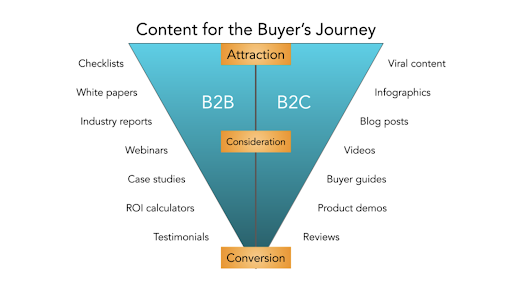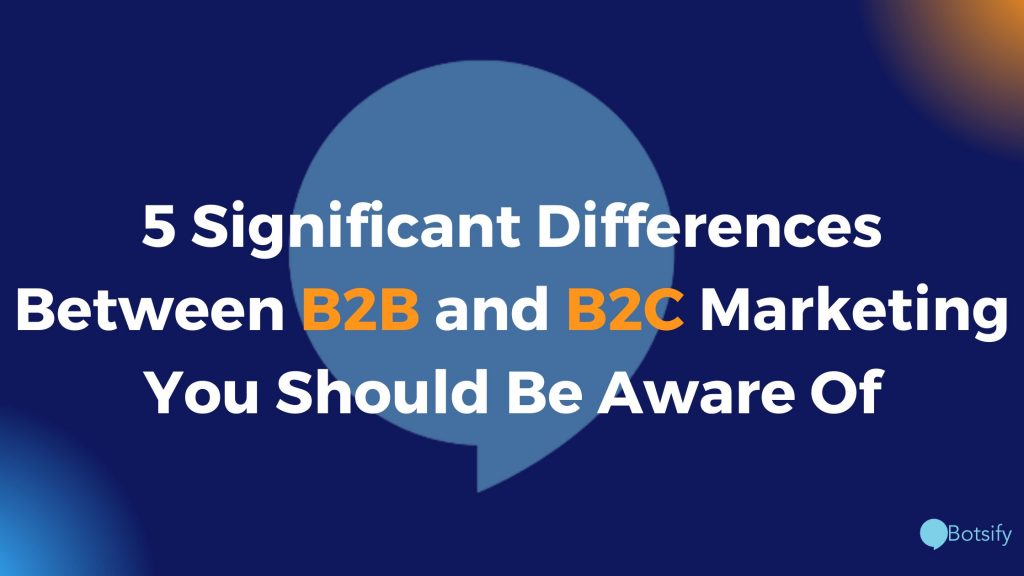There will be times in any professional marketer’s career where they’ll find themselves moving between B2B and B2C marketing. This might be a permanent shift or else a consultant might be talking to clients in both fields.
It’s not always easy to toe the line between the two. That’s because B2B and B2C marketing have some overlap but also some significant differences. In this article, we’ll cover some of these similarities and differences and explain why they exist and how to navigate them.
1. Decision-making
The core difference between B2B and B2C growth marketing strategies is the decision-making process. This is reflected in all aspects, so this article will refer to it throughout, but the main thing you need to know is that the B2B decision-making process is much more complicated.
For that reason, the content of a B2B marketing funnel is very different from that of a B2C one. You can even think of them as different kinds of funnels. Let’s call them “relationship funnels” and “mass funnels”.
The relationship funnel
In the world of B2B, it’s common to talk about “account-based marketing” (ABM). When a company is looking to buy new software, for example, many people will be involved in that decision. The head of IT might have different priorities from senior management, and it’s up to the B2B sales team to navigate those relationships.
A common way to think of the funnel here is awareness, interest, desire, action. The B2B marketing team will focus on building awareness within highly-targeted segments. On LinkedIn, they’ll display sponsored ads to specific job roles or levels of seniority at specific companies.
Someone at the company might show interest by responding to an email or booking a demo. Sales teams will then use tools like LinkedIn Premium to map the decision-makers at the company and bring them through the interest, desire, and action stages.
In B2B, your AOV is usually much higher than in B2C industries, which is why every sale is so important. If you’re a SaaS company charging per seat, one sale could make your financial quarter.
You might have heard of the “80/20 rule”, which states that 20 percent of causes account for 80 percent of the effects. This is why B2B sales teams will often talk about “key accounts” i.e. the customers who are responsible for most of the company’s revenue. That kind of distribution is unheard of in B2C contexts.
The mass funnel
In a B2C context, you’re working with a much bigger funnel with a lower and more predictable AOV. This means you’re trying to get as much aggregate data as possible so you can ensure eCommerce conversion rate optimization.
A similar awareness, interest, desire, action pattern applies to this marketing funnel, but you will never even meet the majority of people coming through it.
In a B2B and B2C eCommerce company, one of those UX teams will be thinking a lot about real, individual people from key accounts. They’ll be working with the sales team to gain their insights and adjust the site accordingly. The B2C UX team will talk a lot about individuals too, but these will be fictional “personas” made up by looking at reams of data.

B2B marketing centers on one-on-one relationships.
2. Relationships
B2C marketing is more emotionally driven than B2B, but as you can see, it’s the B2B marketing and sales process that’s focused on personal relationships.
B2B marketers will spend a lot of time talking to existing customers as well as seeking out new ones. B2B sales teams will also spend a lot of time talking to those key accounts we discussed earlier, either selling them new products or pinpointing their needs.
For some companies, these relationships are a key focus. Stripe, for example, makes a point of having product decision-makers talk to customers as much as possible. See this Twitter thread in which CEO Patrick Collison asks customers what features they’d love to see.
That relevant people from Stripe are talking to customers in the thread is a great product development strategy – and also a useful marketing tool. It encourages engagement and places the needs and desires of the customer at the center. Another example of a B2C business can be a law firm like Torgenson law where they believe in maintaining a healthy and long-term relationship with their clients because they want to provide the best possible service to already distressed clients.
In B2C, you get less time with the individual. You’re also looking at much broader data sets. Segments might contain millions of visitors rather than a couple of hundred. This means A/B testing, UX studies, and other eCommerce tips convert browsers into generic buyers rather than individuals for you to develop long-standing relationships with.
Most of the time your company spends talking to customers will be in the support center. Even then, a lot of those calls will be about transactions like deliveries or subscriptions.
3. Motivation
B2B purchase decisions are logical ones, made after careful consideration of pricing, ROI, and consultations with stakeholders. Product marketing reflects that, thinking about buyers in needs-based segments rather than demographics.
Needs-based segments into which business might fall include:
- Price-focused customers (often small businesses who are focused on getting the most bang for their buck).
- Quality-focused customers, who see this as a strategic investment. They’re looking for the best product from the most respected brand.
- Service-focused customers, who you often see in the fast-moving consumer goods (FMCG) space. Think of shop owners buying cheap wholesale goods. They have many choices about who to buy from, so they’ll gravitate to whoever offers the best customer service and support if something goes wrong.
- Partnership-focused customers, who often end up becoming key accounts. This is common in niche B2B professional services or SaaS categories like legal technology. The service provider is seen as a strategic partner rather than just one vendor among many.
In B2C marketing, however, you’ll see a lot of market research talking about demographics and trends. Because the B2C purchase is so immediate, marketing is focused on telling the consumer an emotional story about who they are, not what they do. The consumer is likely to buy a product that makes them feel cool and in the know, whereas a B2B customer would have a hard time pitching that as an investment to managers.

B2B and B2C marketing funnels have the same structure but different content.
4. Content & Distribution
B2B and B2C marketing funnels have different kinds of content and distribution. In a B2B marketing funnel, the content will include things like whitepapers, industry reports, webinars, case studies, ROI calculators, and testimonials. This reflects the more logical, detail-oriented thinking of a B2B customer.
At every stage, B2B is focused on personalized content and communication. Progress is tracked not in “conversions on page X” but in a CRM or sales engagement platform where individuals are written about in detail.
B2B involves more eCommerce personalisation than B2C. Marketing emails, for instance, will be very specifically tailored to certain segments of the email list in ways that wouldn’t be worthwhile for consumers. A lot of the content is created as collateral for the sales team to give to customers following up from meetings or on-site visits. Onboarding guides might be customized to each company’s branding.
In B2C contexts, the funnel content will include viral content to spread brand awareness, infographics, blogs, videos, buyer guides, and social proof like reviews.
If you look at them side by side, it’s easy to see how B2C marketing is more of a numbers game. Viral content is about getting as many eyes as possible no matter whose, while even the widest part of a B2B funnel is somewhat targeted. At the bottom of the funnel, B2B customers are looking at detailed case studies on companies like theirs. Consumers are looking at an aggregate review score compiled from hundreds of reviews.
Typical in B2C marketing is a performance marketing definition of success, where partners and affiliates are paid per conversion. That could be anything from a click-through to the site to an actual purchase. This allows marketers to cast their net very wide while keeping a good return on ad spend, which is so important in big B2C campaigns.
This is less common in B2B campaigns, where marketers are typically paid up-front. It’s assumed they’ve done their research into who’s going to be seeing the campaigns.
In either context, branding is crucial. Any marketer should be keeping the brand in mind as they optimize marketing campaigns using a CX lens. For many B2C companies, the brand is all that distinguishes their widget from their competitors’. The more immediate and emotional B2C funnel lends itself toward a focus on brand awareness and loyalty.

B2C marketing is more attention-grabbing, emotive, and widely targeted than B2B marketing.
5. Sales Cycles
In some exceptional cases, a company might urgently need your product, and you’ll see them go from awareness to purchase in just a week. In almost all cases, though, B2B marketing and sales teams are prepared for weeks or months-long sales cycles. In many B2B SaaS contexts, firms will also sign annual contracts using contract management software. This means they can’t even consider new purchases until the beginning of the following year.
The length of this sales cycle is another reason B2B marketing funnels are so high-touch and personalized. If a young company is dealing with these long, complex sales cycles it takes much more time for them to iterate on their marketing funnels.
In contrast, the B2C sales cycle is short and simple. It takes mere minutes, and often the customer visits only one web page before they’re ready to check out. These short sales cycles allow markets to gather analytics data on what works much faster. The data gathered is mostly anonymous, but the speed of it allows them to iterate faster than B2B marketers.
Navigating the two
The B2B sales cycle is longer, more logical, yet more personal than the B2C cycle. This one factor accounts for many of the differences between B2B and B2C marketing strategies.
If you find yourself moving between the two, you can see there’s a lot of overlap, but after reading this, you should start to see even more significant differences between the two that all stem from this one root cause.

